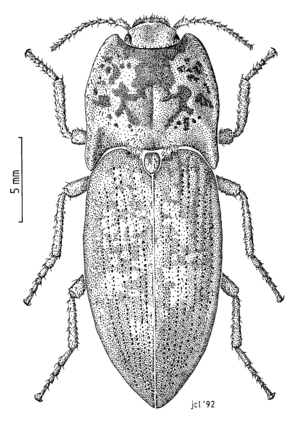Three Kings click beetle facts for kids
Quick facts for kids Three Kings click beetle |
|
|---|---|
 |
|
| Amychus manawatawhi by Joanna Liddiard | |
| Conservation status | |
|
Invalid status (NZ TCS)
|
|
| Scientific classification | |
| Genus: |
Amychus
|
| Species: |
manawatawhi
|
The Three Kings click beetle (scientific name: Amychus manawatawhi) is a large beetle. It belongs to a group called click beetles. But this special beetle cannot fly! You can only find it on the Three Kings Islands in New Zealand.
Contents
How the Beetle Was Found and Named
This beetle was first named and described in 2010. Two scientists, John Marris and Paul J. Johnson, did this work. They studied a special beetle that was found in 2006. It was found in a place called Lighthouse Bush on Great Island. This island is part of the Three Kings Islands. The first beetle they studied is now kept at the Lincoln University Entomology Research Collection.
The beetle's scientific name, manawatawhi, comes from the Māori name for Great Island. That name is Manawa Tawhi. It means "panting breath." This name tells a story about a chief named Rauru. He swam to the island from the mainland.
What Does the Three Kings Click Beetle Look Like?
Adult Three Kings click beetles are easy to tell apart from other similar beetles. They do not have small bumps on their backs. Other beetles like A. granulatus and A. candezei do have these bumps.
This beetle is the largest of its kind. It can be from 16 to 24 millimeters long. That's about the size of a small coin. It has a flat body shape. It also has tiny wings that it cannot use to fly.
Click beetles are known for a special trick. If they get flipped onto their backs, they can make a loud "click" sound. This helps them jump into the air and flip over. But the Three Kings click beetle cannot do this. It does not have this way to defend itself.
Where Does the Three Kings Click Beetle Live?
This special beetle has only been found on two islands. These are Great Island and South West Island. Both are part of the Three Kings Islands group.
These islands have been separate from New Zealand for a very long time. This means many unique animals and plants live there. It is very likely that the Three Kings click beetle developed on these islands. It has probably always lived only there.
How the Three Kings Click Beetle Lives
Adult Three Kings click beetles are often found at night. They have been seen on logs and tree trunks. Some trees they like are Cordyline kaspar, Kunzea sinclairii, and Meryta sinclairi. During the day, they have been found in traps. They are also found under logs and rocks.
So far, only one young beetle (larva) has ever been found. It was found on South West Island.
Protecting the Three Kings Click Beetle
The Department of Conservation has a special list. They have classified the Three Kings click beetle as "Naturally Uncommon." This means it is not found in many places. It is naturally rare.
In the past, goats were brought to Great Island in 1889. Goats can eat many plants and change the environment. But the goats were removed from the island in 1946. This helped protect the beetle's home.
Images for kids




